Heritage Meal as Social Lubricant?
This time of the year some people exchange cooking at home for cooking at a large neighborhood gathering.
-
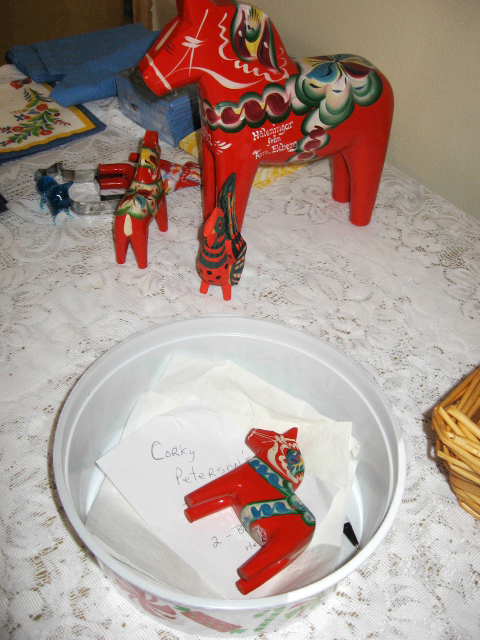 After the annual Swedish dinner at the Siloa Lutheran Church, tables were cleared and all Dala horses herded together, ready to be sent back to their various owners. Photo by V. S. Arrowsmith
After the annual Swedish dinner at the Siloa Lutheran Church, tables were cleared and all Dala horses herded together, ready to be sent back to their various owners. Photo by V. S. Arrowsmith -
-
Maple Ridge in Isanti County, MN—Church suppers are a regular part of the autumn calendar in east central Minnesota. At this time of year a heritage food follower can exchange cooking at home for cooking at a large gathering somewhere in the neighborhood, with the advantage of dining with others one only sees on these public occasions. Or perhaps the meal serves as a social lubricant for the somewhat shy and taciturn Nordic types. One can eat in quiet, or engage in conversation with a neighbor as needed or desired. In any case, work and life seem to have replaced entertaining on the home front for many, so these gatherings are an opportunity to meet and greet folks who share a similar cultural or heritage background, or who simply live in the same zip code ... with the added benefit of having no dishes to wash afterward.
-
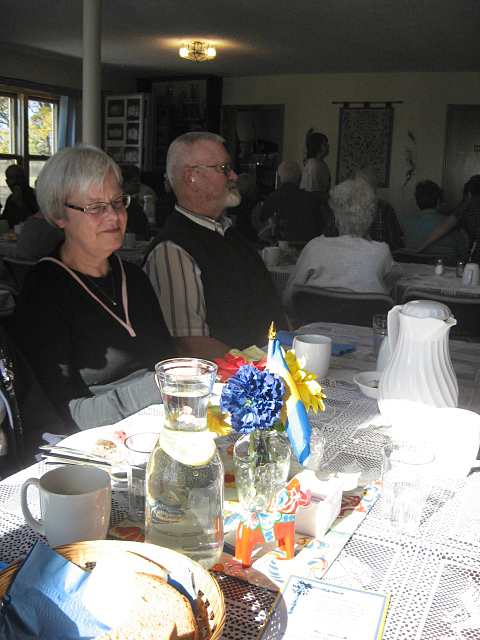 Siblings Karen Pauls and Ross Nelson were fully satisfied after enjoying a Swedish dinner at the Siloa Lutheran Church. The tables were covered by lace cloths and decorated with floral centerpieces that also included a Dala horse, a Swedish flag and a menu written in Swedish. Plenty of good coffee was available throughout the meal. Photo by V. S. Arrowsmith
Siblings Karen Pauls and Ross Nelson were fully satisfied after enjoying a Swedish dinner at the Siloa Lutheran Church. The tables were covered by lace cloths and decorated with floral centerpieces that also included a Dala horse, a Swedish flag and a menu written in Swedish. Plenty of good coffee was available throughout the meal. Photo by V. S. Arrowsmith -
-
Such was the case at the Siloa Lutheran Church in rural and agricultural Maple Ridge Township. The little country church is located in Isanti County, called “America’s Dalarna,” due to its history of many Swedish families from that province, which immigrated to this part of Minnesota after the 1860s. Many descendants continue to live in the county today.
-
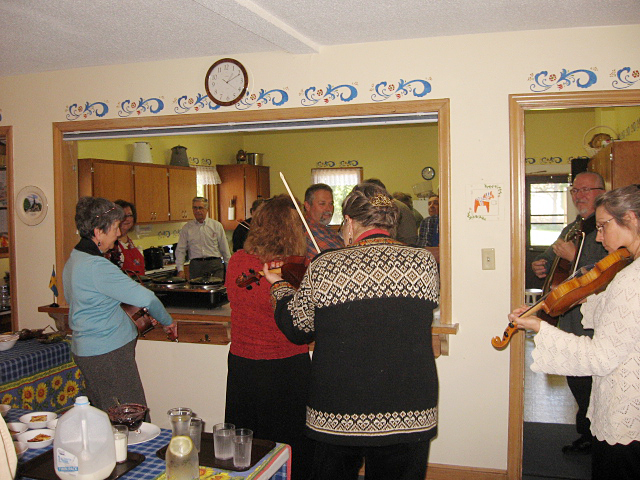 Members of the Scandiband gave the Siloa Lutheran Church kitchen workers their own encore by playing a Swedish tune in thanks for their efforts to serve a traditional Swedish dinner. The heritage meal occurs on the fourth Sunday of October every year. Photo by V. S. Arrowsmith
Members of the Scandiband gave the Siloa Lutheran Church kitchen workers their own encore by playing a Swedish tune in thanks for their efforts to serve a traditional Swedish dinner. The heritage meal occurs on the fourth Sunday of October every year. Photo by V. S. Arrowsmith -
The church still has native speakers of Swedish, plus a Swedish language teacher who is also a professional Scandinavian hand weaver. His weavings serve as church paraments during the liturgical year. In addition, judged by the vast array of items for sale in its marknad at the dinner, it has a bevy of bakers who can produce limpa and other foods from the Nordic heritage.
-
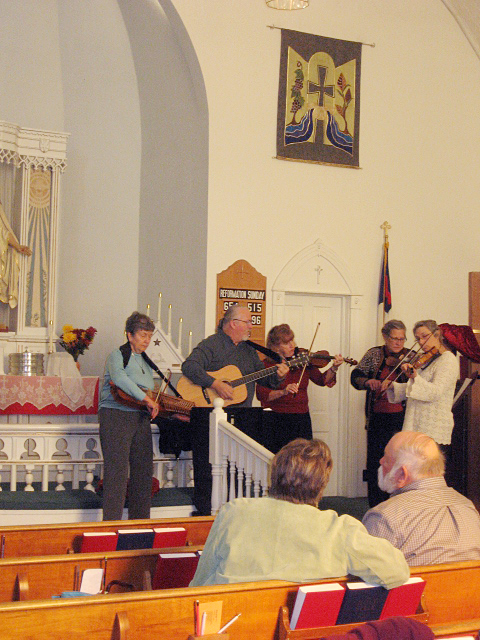 The Scandiband from Isanti and Kanabec counties in east central Minnesota consists of nyckelharpa, guitar and fiddles. They provided appetizer music for guests waiting to partake of the annual Swedish dinner prepared and served by members of the Siloa Lutheran Church near Braham, MN. Photo by V. S. Arrowsmith
The Scandiband from Isanti and Kanabec counties in east central Minnesota consists of nyckelharpa, guitar and fiddles. They provided appetizer music for guests waiting to partake of the annual Swedish dinner prepared and served by members of the Siloa Lutheran Church near Braham, MN. Photo by V. S. Arrowsmith -
A couple hundred folks enjoyed the most recent sunny, noon-time dinner, music and good conversation. While some made dates for the lutfisk community supper—at Cambridge Lutheran Church—always on the first Thursday of November, others waited to partake of the repast of potato sausage, meatballs, potatoes, peas, beet pickles, rice pudding and plenty of coffee. Music was performed by the 2-year-old Spirit River Scandiband. The group formed specifically to foster interest in Nordic dance in the region. There are fiddles, guitar, and nyckelharpa in the band.
-
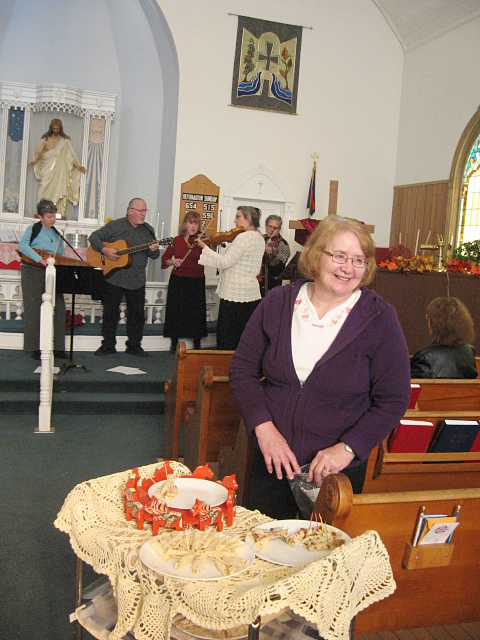 Lefse treats were served to those waiting to dine at the annual Siloa Lutheran Church Swedish Dinner in east central Minnesota. In the background the Spirit River Scandiband performs. Photo by V. S. Arrowsmith
Lefse treats were served to those waiting to dine at the annual Siloa Lutheran Church Swedish Dinner in east central Minnesota. In the background the Spirit River Scandiband performs. Photo by V. S. Arrowsmith -
The Scandiband recently took part in a workshop, taught by musicians from the Ole Olssons Old Time Orkester, to help make their music more danceable. The members felt they had improved from the experience, as witnessed by a good response from a recent gig at the Cambridge Baptist Church anniversary. After that performance, in which they stated before each tune what sort of dance it was meant for, people from the congregation approached them expressing strong interest in learning the dances. Perhaps after 140-plus years, some of the early immigrant-era church strictures against dance are easing and maybe the Scandiband will help folks recognize that they can re-embrace a tradition that used to include dance. Maybe there can even be another social lubricant besides the regular fall gatherings for heritage food to help support the descendents of Swedish immigrants as a community.
-
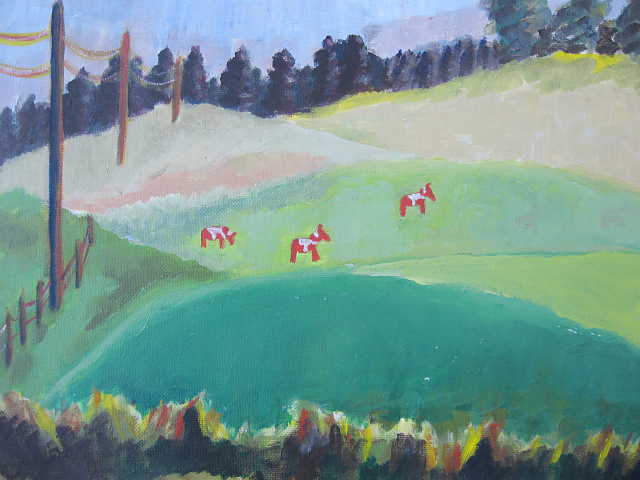 After an immersion in cultural heritage through a Swedish dinner at the Siloa Lutheran Church, this reporter thought she noticed Dala horses grazing in a neighboring pasture in Maple Ridge Township. What she will see after an upcoming lutfisk supper remains to be seen. Photo by V. S. Arrowsmith
After an immersion in cultural heritage through a Swedish dinner at the Siloa Lutheran Church, this reporter thought she noticed Dala horses grazing in a neighboring pasture in Maple Ridge Township. What she will see after an upcoming lutfisk supper remains to be seen. Photo by V. S. Arrowsmith -
-
